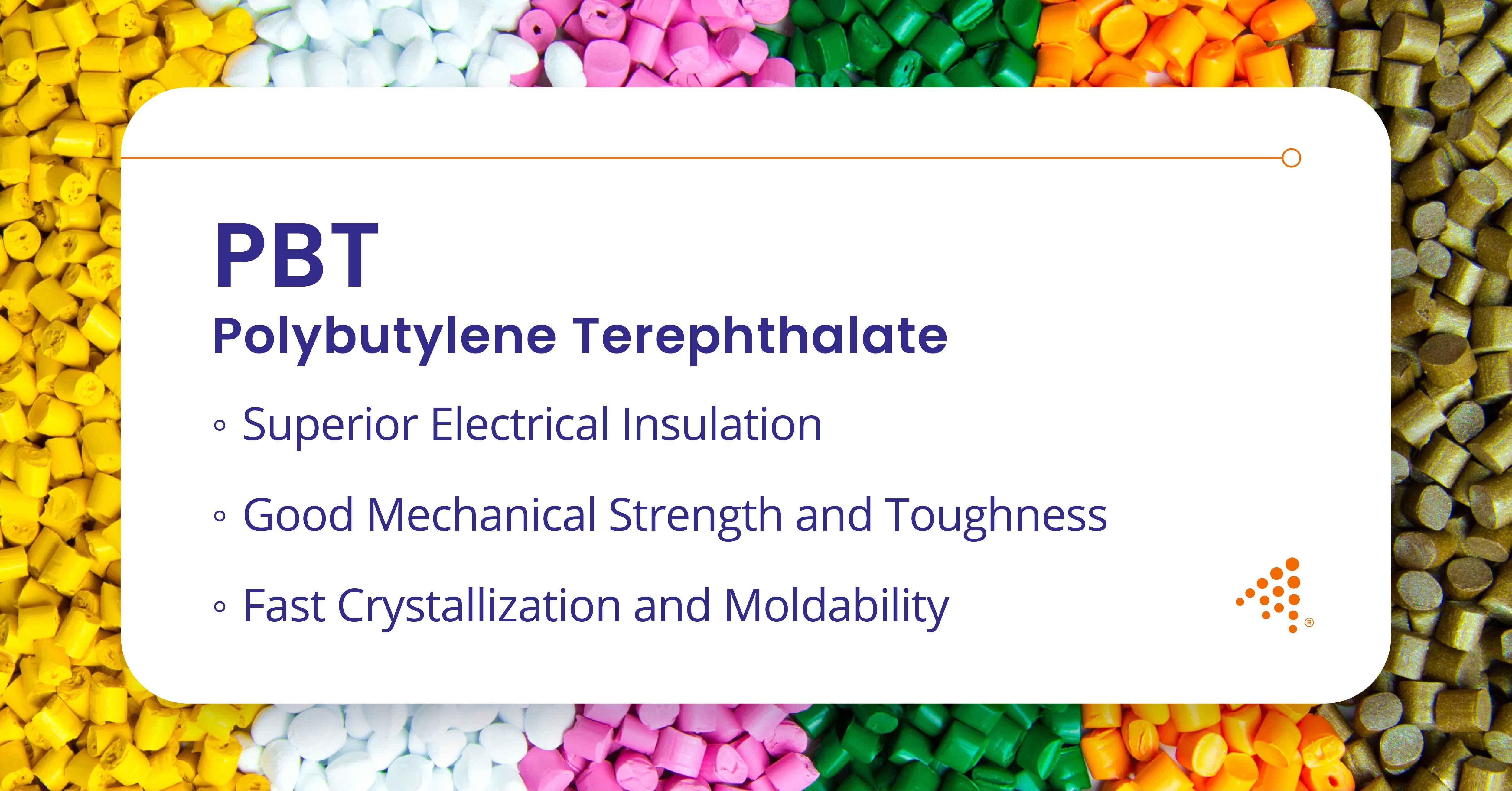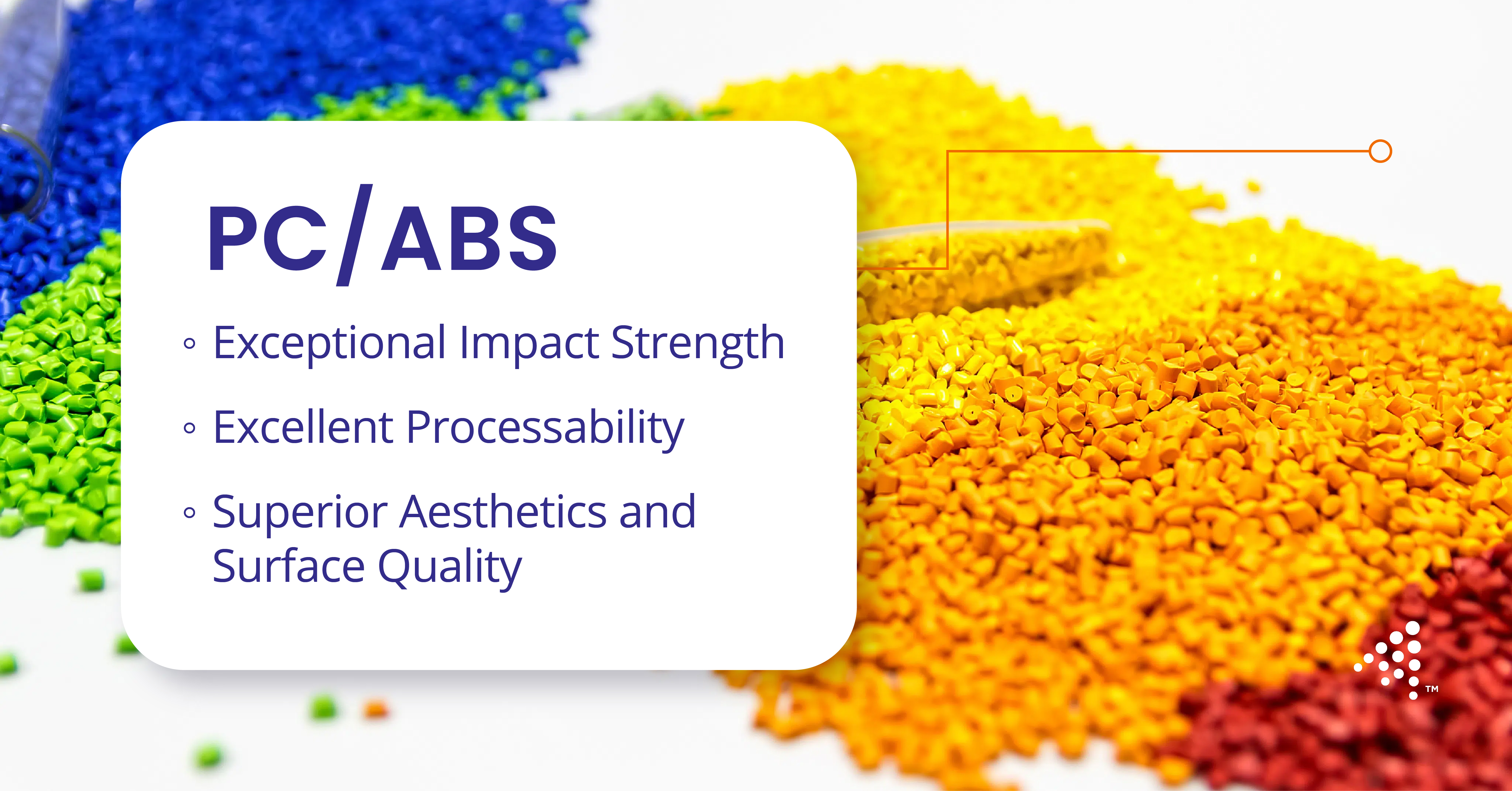PC/ABS Resin: Durable, Versatile & High-Performance
Polycarbonate/Acrylonitrile Butadiene Styrene (PC/ABS) is an engineering thermoplastic alloy, created by blending the two materials. This powerful...

Polybutylene Terephthalate (PBT) is a high-performance thermoplastic resin known for its chemical resistance, moderate heat tolerance, and strong electrical insulating properties. PBT is commonly used in industries requiring materials that can withstand harsh environments while maintaining dimensional stability and reliability.
PBT maintains its shape and mechanical properties exceptionally well under varying temperatures and stress. Its low moisture absorption and resistance to warping make it a reliable material for parts requiring tight tolerances, especially in automotive and electrical components.
One of PBT’s standout traits is its electrical insulating capability. It exhibits high dielectric strength and low dissipation factor, even in humid conditions, making it ideal for connectors, switch housings, and other electronic applications.
PBT has a strong balance of rigidity and toughness. It offers good tensile strength and impact resistance, even at low temperatures. When reinforced with glass fibers, PBT can withstand higher stress loads and mechanical wear.
PBT resists a wide range of chemicals, including solvents, oils, greases, and dilute acids and bases. This chemical stability extends its service life in harsh industrial and automotive environments.
PBT crystallizes rapidly during cooling, which reduces cycle times during injection molding. This makes it highly efficient for high-volume production, especially when creating complex or precision parts.
Unmodified PBT can tolerate continuous-use temperatures up to around 130°C (266°F), and certain grades can handle even higher. It’s suitable for applications where heat exposure is consistent but not extreme.
Unfilled PBT has a naturally low coefficient of friction, which can be enhanced with additives. This characteristic is useful in sliding components, bearings, and gears.
PBT offers excellent surface quality with a smooth, glossy appearance after molding. This enhances both aesthetics and functionality in visible consumer parts or components that require a clean, professional finish.
PBT’s unique blend of thermal stability, dimensional accuracy, and electrical insulation makes it a go-to engineering thermoplastic for a range of demanding industries. Its rapid moldability and resistance to chemicals and moisture give it versatility in everything from automotive components to medical equipment. Below are some of the most prominent and widely adopted uses of PBT:
PBT’s chemical resistance and ability to maintain dimensional stability under sterilization make it a strong candidate for medical injection molding. It’s used in non-implantable components such as diagnostic housings, surgical tool handles, and tubing connectors, especially when aesthetics and performance are both essential.
PBT is extensively used in the electrical sector for switch housings, connectors, circuit breaker parts, and coil bobbins. Its dielectric properties, flame retardancy, and resistance to soldering heat make it especially valuable in automotive wiring harnesses and electronic control units.
Thanks to its mechanical durability, thermal resistance, and low friction, PBT is widely used in injection molding for automotive applications. Common components include sensor housings, door handles, fuel system parts, and under-hood connectors. It withstands vibration, chemical exposure, and temperature fluctuations reliably over time.
With its attractive surface finish and electrical insulation, PBT is found in appliance parts, keyboard frames, laptop charger cases, and smartphone brackets. It offers the durability and look needed for high-end consumer-facing products.
PBT is often selected for mechanical components such as gears, pump housings, and fans where low friction and wear resistance are critical. Glass-reinforced PBT grades offer added stiffness and thermal resistance for demanding industrial equipment.
In home appliances, PBT is used in items like coffee machine components, dryer vents, and dishwasher parts due to its resistance to heat, moisture, and chemicals. Its ability to retain shape and color over time adds to its value in long-life household products.
Due to its dimensional stability and electrical insulation properties, PBT is increasingly used in LED housings, reflectors, and lamp holders. It tolerates heat and maintains form even with prolonged use.
PBT is highly adaptable and can be tailored to meet specific performance demands across a range of industries. Through the use of fillers, reinforcements, and additives, manufacturers can optimize PBT for improved mechanical strength, flame resistance, processing efficiency, and more. These modifications are especially valuable in settings such as medical injection molding, automotive manufacturing, and electronics, where material performance must meet precise standards.
One of the most common modifications, glass fiber reinforcement dramatically increases the strength, rigidity, and heat resistance of PBT. Glass-filled PBT grades are used in structural automotive and electronic components that demand dimensional stability and minimal warping under stress.
To meet stringent flammability standards, particularly in the electronics and appliance sectors, PBT can be compounded with halogenated or halogen-free flame retardants. These additives help the material meet UL 94 V-0 ratings and reduce the risk of ignition in high-temperature environments.
To enhance toughness and resist cracking under sudden impact, especially in cold environments, PBT can be modified with rubber-based impact modifiers. These are useful for both industrial applications and durable consumer products where shock resistance is important.
For outdoor applications or components exposed to light, UV stabilizers can be added to prevent degradation and discoloration. This ensures that PBT parts retain their appearance and performance even after prolonged sun exposure.
PBT naturally offers good colorability, but specific dyes and pigments can be added to achieve precise hues, improve aesthetics, or help with product identification, especially in medical or consumer-facing products where color coding is beneficial.
Internal lubricants such as PTFE or silicone can be incorporated into PBT to reduce friction and improve wear resistance. Processing aids also enhance mold flow and release properties, making the material easier to handle in injection molding applications.
These additives are used to control and accelerate the crystallization process during cooling, improving surface finish and dimensional precision. This is especially useful for complex parts requiring tight tolerances and fast cycle times.
In electronics manufacturing, PBT can be modified with antistatic agents or conductive fillers like carbon black to manage static buildup or allow controlled conductivity in sensitive environments.
While PBT offers a compelling mix of mechanical strength, electrical insulation, and chemical resistance, it’s not without limitations. Understanding its drawbacks is essential for choosing the right material for demanding environments, particularly in medical injection molding or precision applications where even small compromises can have a significant impact.
PBT is sensitive to moisture at high temperatures. In humid or steam-based environments, it can undergo hydrolysis, leading to a loss of mechanical integrity over time. For medical or food-contact parts that require repeated steam sterilization, this can be a limiting factor unless a hydrolysis-resistant grade is used.
PBT’s semi-crystalline nature can lead to shrinkage and warping if not carefully managed during the cooling process. This dimensional instability can be problematic for tight-tolerance applications like precision housings or connectors.
Without impact modifiers, unreinforced PBT tends to be brittle, especially at lower temperatures. This can make it vulnerable to cracking under mechanical shock or sudden stress. Applications involving drop resistance or vibration may require a tougher blend.
Although PBT performs well under moderate heat (with a melting point around 223°C), prolonged exposure to higher temperatures can lead to softening, creep, or degradation. For sustained use in high-heat environments, other engineering thermoplastics like PPS or PEEK may be better suited.
Like many thermoplastics, PBT has low surface energy, which can make it challenging to bond with adhesives or print on without pretreatment. Methods such as plasma treatment or corona discharge may be necessary for secure adhesion in labeling or assembly.
PBT is a versatile engineering thermoplastic known for its strength, chemical resistance, and electrical insulation properties. Its ability to maintain structural integrity under heat and mechanical stress makes it a popular choice in demanding industries, from automotive and electronics to consumer and medical manufacturing.
In medical injection molding, PBT offers the durability, dimensional stability, and sterilization compatibility needed for precision components like connectors, housings, and diagnostic equipment. Whether you need a flame-retardant formulation, enhanced hydrolysis resistance, or a blend with improved impact performance, PBT can be tailored to meet the unique demands of your application.
At Aprios, we can help you choose the right PBT material for your specific needs. Get in touch for expert advice and solutions tailored to your project!
You can also view our Material Selection tool.

Polycarbonate/Acrylonitrile Butadiene Styrene (PC/ABS) is an engineering thermoplastic alloy, created by blending the two materials. This powerful...

When a single material doesn't quite meet the rigorous demands of a complex part, engineers often turn to polymer blends to achieve a superior...

Polyphenylene Ether (PPE), also sometimes known commercially as Polyphenylene Oxide (PPO), is a high-performance amorphous engineering thermoplastic...